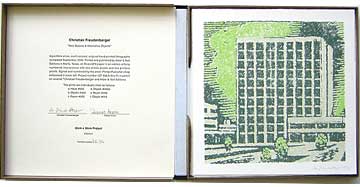
view all |
 |
Christian Freudenberger, "New Spaces and Alternative Objects," 2008
The objective of neutrality is to neither offend nor defend; it has no Glock; its gaze is vacant. It hovers, hesitates, hangs back, and waits. If these series of spaces created by Christian Freudenberger are indeed neutral, then why? What will this neutrality produce in you, me, the gallery (and so on)? Furthermore, what non-neutral forces flank and pressure these prints? Some might be tempted to automatically dub these averted forces as Minimalism, Impressionism, and Pop Art, but we can also unfetter these categories by renaming them property, light, and celebrity.
During his two-month tenure as Chinati Artist in Resident—Marfa, Texas— Freudenberger managed to dodge the weight of history by departing from familiar local visions (i.e.: Donald Judd - the object as an end to itself, Ingolfur Arnarrson- natural sunlight as medium equal to graphite, and John Wesley-the passive-aggressive tactic of flattening the iconic). Does this mean we get to call Freudenberger an artful dodger? After all, he's neatly sidestepped these powerful influences, only to quietly and carefully assemble images that do not stake claim to a precise movement or moment.
Freudenberger's hesitation isn't entirely relegated to the aesthetic; a critical dithering reflects a certain compulsion to temporally locate his work in the in between. Joseph Vogel, German philosopher and literary scholar, speculates that
"hesitation [is] a state of being that implies much more than a lack of movement: hesitation makes the dimension of time and history visible and therefore stimulates a sense of possibility."
Freudenberger further compromises time and history when he asks that his work be lodged in another dimension. He writes, "The 6 prints are one piece. [Although they are] Different rooms/spaces and objects?[T]he idea is that everything happened to the same time..."
This notion requests that viewers suture together a space where chronology has been discontinued—a place that refuses to turn towards the future or the past. This stylized landscape of " an endless present" includes a clownish water fountain burbling infinitum, a placid grey-tone bedroom, and a partial view of a geometric pink sculpture surrounded by trees. All are bathed in the same plain light— this relentless sun with its ersatz shadows— and as a result this viewer is suddenly very conscience of her intense compulsion to abandon the present and to simultaneously grope her way back (and forwards!) towards dawn (and dusk). Who is the Art(less) Dodger now? Why abandon the radical possibility suggested by Vogel and visualized by Freudenberger? Who knew neutrality was so threatening? Who knew it was (potentially) a holding tank for liberation?
The passive spaces and frozen objects generated by Freudenberger's stroke of the pen should not be equated with silence. His visualizations of sound exceed what one might call a presupposed room tone: there are bodies rustling under the covers and the bright pink tracer of a beast's leap through the air zings metallic. There's a soundtrack to neutrality and Freudenberger has provided us with a score or rather, some tracks. His 'ensemble' is not unlike the Bauhauskapelle's (Bauhaus Orchestra) found object orchestra. But he's swapped their sirens and gunshots for tree branches scraping against windows and sculptures and the almost imperceptible blowing sound emitted by a puff of smoke; a water fountain making nothing other than water fountain noises. The twin shadows of an animal body just right of the frame suggest the boing of a heavy bounce, and in another print, the blanketed but rising forms insure an arpeggio of slurps. What could initially be read as Freudenberger's attempt to duck away from the full force of property, light, and celebrity, is revealed to be an illustrated soundtrack, telling tales-alternately lonesome, civic, crippled, cool, salty and athletic.
by Mary Walling Blackburn
Composed by Christopher Marianetti and based on Freudenberger's images.
Instruments: the sound of of a pencil drawing figure eight on wooden table, acoustic recording of digital noise from an 1/8 inch jack, birds, wine glasses, bricks on cement.
|